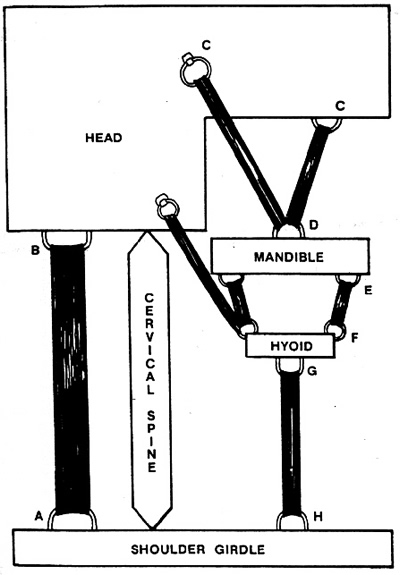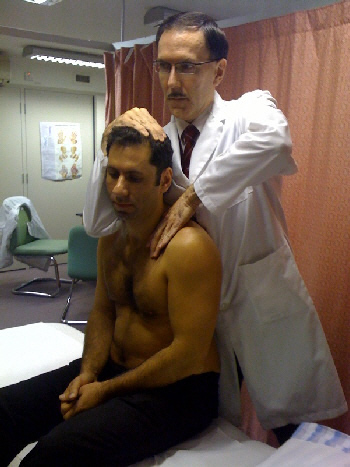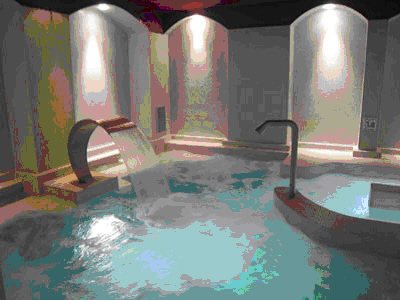Positive Health Online
Your Country

Osteopathy, Movement and Water: Perfect Union for the Well-being of the Cervical Region
listed in osteopathy, originally published in issue 169 - April 2010
The cervical part of the vertebral column is like a pillar that supports our head just as the mythological Atlas supported the celestial world on his shoulders; for this reason it is not a coincidence that the first cervical vertebrae is called exactly that, atlas.
The cervical region (made up of 7 vertebrae, while there are 12 thoracic and 5 lumbar vertebrae) must fulfil two almost conflictual duties; supporting the weight of the head while at the same time allowing it enough movement to be able to carry out the fundamental function of vision. This is carried out by the fine tuning of the muscles of the cervical region which coupled with the joints they serve is known as The Stomatognathic System.[1]

Many different diseases inevitably strike such a complex system, both acute and chronic. The most common of these is cervicalgia, localized pain in the upper region of the vertebral column.
This pain can be as a result of different tissue sub layers: bones, skin, profound somatic structures (discs) or muscles. The latter is the most frequent cause of cervico-cephalgia. In fact, alterations in the functioning of the neck muscles, as it is possible to see in cervical tension or tension-type headaches, are very common. Excessive and prolonged stress on this muscle, stress caused by postural changes or acute traumas such as the notorious 'whiplash' can induce pain:
a) Because of excessive strain/pressure on the muscle insertion;
b) Because of the inflammation of the muscle (resulting from metabolic modifications brought about during a non-physiological prolonged contraction);
c) Ischemia, as in repetitive strain syndrome known as myositis (a prolonged static contraction of the whole musculature of the neck);
d) Arthritis-like phenomena found on the facet joints of the vertebrae that bring about tissue degeneration and the formation of osteophytes (bone spurs);
e) Modifications to the physiological curvature of the cervical region as a result of a 'defensive' contraction carried out by the profound musculature of the backbone in response to an external hit (whiplash). In this case, the musculature contracts suddenly as part of a defence mechanism. Such a contraction leads to a reduction, if not an inversion, of the normal curvature of the cervical region, with the disc and ligament structure coming under an enormous amount of strain.[2]
In all the above cases Osteopathy and Kinesitherapy are recommended.[3] The latter in particular has proved to be effective in correcting an unbalanced muscular system and improving bad posture, through a series of manipulation and soft tissue techniques.[4]
A 1996 Rand study revealed that cervical spine manipulation in the absence of pathology would provide at least short-term pain relief and increased cervical range of movement in persons with sub-acute or chronic neck pain.[5]

Kinesitherapy uses a series of coded exercises that allow, in succession, the resolution of possible muscle contractures and the strengthening of weakened muscles. A particular aspect of kinesitherapy is that it takes place in water, in thermal (spa) water to be more precise. Hot or thermal water acts via two fundamental mechanisms: the first is purely physical, the reduction of the load on the column. The constant weight of the head on the spine is reduced, thanks to the well-known law of Archimedes (a body completely or partially immersed in a fluid receives a direct push from the bottom upwards equal to the weight of the displaced fluid). Conversely, the second mechanism is linked to physiological reactions of the organism immersed in water, and more specifically, in hot water. Firstly, in water, the proprioceptive and exteroceptive sensory systems (the receptors that register what is happening in the body and in the environment around the body) react differently compared to when the body is out of water. Most noticeable is the reduction in muscle tone; such a reduction can help resolve aches and pains provoked by spasms or muscular contractions, by allowing a reorganization of body motion and order. This is thanks to a synergetic action, in other words, changes in the habitual motor systems and in both the proprioceptive and exteroceptive responses. And it is also this reduction in muscle tone caused by the elevated temperature of the hot or thermal water, which brings about the resolution of painful contractures if the actions of these mechanisms are coupled with specific exercises,[6] aided by the activity out of water, but appropriately modified for the aquatic environment. The effect, with regard to the elimination of the painful condition and thus return to normality, will be cumulative. It is important however, that workers in this field are adequately prepared, not only on the specific pathology but also on the characteristics and needs of the activity taking place in water, which is similar yet also different to that which happens out of the water.
Cervical waterfalls: Lastly, one last piece of advice for all guests of spa hotels and, in general, all those who love going to spas. Cervical waterfalls are very good for the neck and shoulders as long as they are used in the correct way. Therefore benefit from the jets of water maintaining the shoulders and the cervical spine just above the water's surface.

Some practical examples of simple exercises for the cervical region that can be carried out both in and out of the water.
A1 Bend the head towards the left, while holding your right wrist. Then pull your right arm towards the left (so lowering the right shoulder) and maintain this position for at least 20 seconds.
The aim of this exercise is to pull the right shoulder away from the corresponding ear, thus lengthening the lateral musculature of the neck (the ascending muscle fascicle of the trapezium).[6]
A2 The same exercise can also be carried out in water, passively, with the help of a personal trainer (in this case the benefits will be greater thanks to the effect of the heat).
B1 Auto massage of the trapezium and the cervical region with the opposite hand. The aim of this exercise is to relax the lateral musculature of the neck.
The same exercise can also be carried out in water (B2) both autonomously and with the help of a personal trainer.
These exercises are very simple and anybody can do them autonomously; however for those exercises that will be carried out in water, the help of somebody who is justly qualified is recommended, as the risk of making a mistake is higher.
References
1. Walther DS. Applied Kinesiology, Vol 1 Systems DC, Pueblo, DC. 1983.
2. Freeman MD, Croft AC, Rossignol AM.Whiplash associated disorders: redefining whiplash and its management" by the Quebec Task Force. A critical evaluation. Spine 23 (9): 1043-9. 1998. doi:10.1097/00007632-199805010-00015. PMID 9589544.
3. National Institute for Clinical Excellence. www.nice.org.uk 2009.
4. Bronfort G, Assendelft W J, Evans R, Haas M, Bouter L. Efficacy of spinal manipulation for chronic headache: a systematic review. Journal of Manipulative and Physiological Therapeutics. 24(7): 457-466. 2001.
5. Constantoyannis C, et al: Intermittent cervical traction for cervical radiculopathy caused by large-volume herniated disks, J Manipulative Physiol Ther 25(3):188-192. 2002.
6. UK BEAM Trial Team. United Kingdom back pain exercise and manipulation (UK BEAM) randomised trial: effectiveness of physical treatments for back pain in primary care. BMJ. 329 (7479): 1377. 2004.
Bibliography
Gray's Anatomy: The Anatomical Basis of Clinical Practice, 40th edition, 1576 pages, Churchill-Livingstone, Elsevier. ISBN 978-0-443-06684-9. 2008.
Ferrari R. The Whiplash Encyclopedia: The Facts and Myths of Whiplash. Jones and Bartlett. ISBN 0763729345. 2006.
Ward, Robert C. et al; Foundations for Osteopathic Medicine (2nd ed.). Philadelphia: Lippincot Williams and Wilkins. ISBN 0-7817-3497-5. 2003.
Comments:
-
No Article Comments available